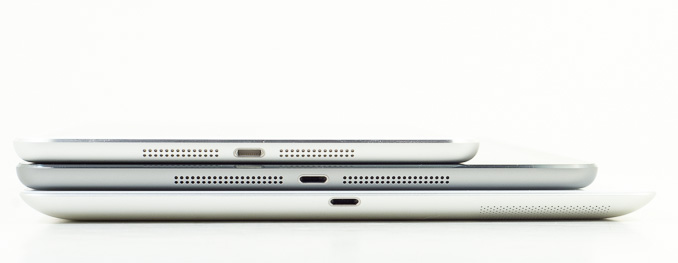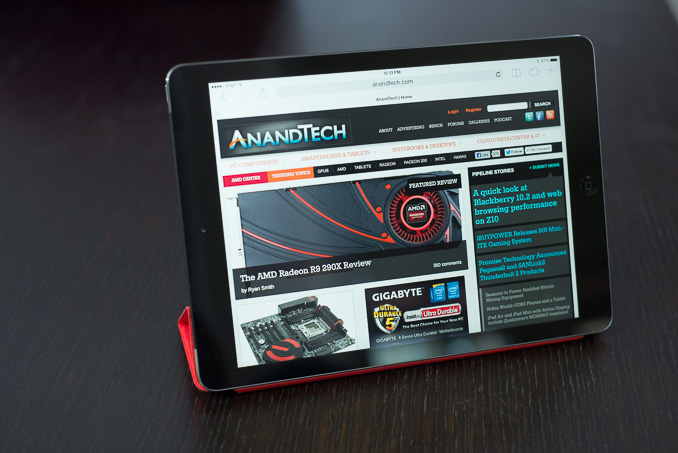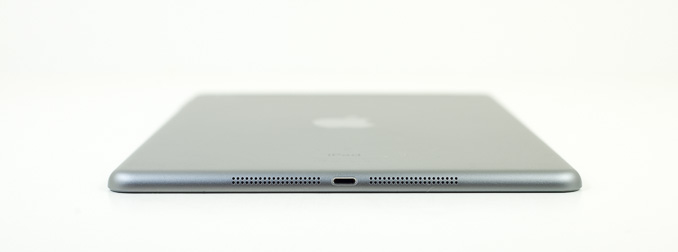The iPad Air Review
by Anand Lal Shimpi on October 29, 2013 9:00 PM ESTFinal Words
Two weeks ago I had all but written off the bigger iPad. It was too bulky and just no where near as portable as the iPad mini. Once the latter gets a Retina Display and equal hardware across the board, why would anyone consider the bigger model?
The iPad Air changed my perspective on all of that. It really does modernize the big iPad. While I suspect there are still going to be a lot of users who prefer the smaller form factor of the iPad mini with Retina Display, I do feel like there are those users who will continue to appreciate all of the benefits that go along with having a larger display. Text is easier to read, particularly on desktop versions of websites. Photos and videos are larger and thus more engaging as well. In the past there was this complex matrix of tradeoffs that you had to make between iPad and iPad mini. This generation, Apple does away with all of that.
All you need to do is pick your screen size. If you prefer the 9.7-inch form factor of the original iPad, the Air gets you as close as possible to a mini without giving up that display size.

From top to bottom: iPad mini, iPad Air, iPad 4
The name does the product justice in this case. In two hands or lightly propped up against something (palm, legs, chest), the iPad Air feels incredibly light - the weight just seems to disappear. The larger chassis doesn’t feel very dense at all. The in-hand feel of the device is really unlike any other iPad. It feels like a lightweight slate, rather than a heavy computing device. This is the iPad that Apple likely wanted to launch on day 1, it just took a bit over three years to get here.
Build and material quality are of course excellent. The iPad Air borrows much of the design language from the iPad mini, and makes the transition to a larger display quite nicely. The Air ends up looking a lot more modern than its predecessor.
Despite making the transition to a thinner touch and display stack, the iPad Air’s display is every bit as good as previous Retina Display iterations. Color accuracy remains best in class, delivering an out of box display experience that’s better than most systems, even at substantially higher price points. The only thing that the iPad Air leaves me wanting on the display front is a lower reflectance stack. Laminating the cover glass to the LCD panel is something that Apple does on both the iPhone and iMac, it’s time that the same feature is brought down to the iPad.
Apple’s decision to unify silicon across the iPhone 5s, iPad Air and iPad mini with Retina Display is an interesting one, but ultimately it doesn’t come with any real tradeoffs for iPad owners. Apple’s own 64-bit Cyclone cores are incredibly powerful, even more so than I originally expected when I reviewed the iPhone 5s. Apple seems to have built a bigger, higher performance CPU architecture than any other ARM player, including ARM itself. The design isn’t perfect, but it’s a completely different caliber performer than anything else it competes against. As such, Apple was completely justified in putting the A7 in both the iPhone 5s and the iPad Air. If anything, I’d argue that it might be overkill for the 5s given the device’s smaller battery, but my sensibilities soon get the best of me and remind me that more performance on tap is never a bad thing.
On the GPU front, Apple does increase performance over the iPad 4 as well - despite having a narrower memory bus. The increase in performance ranges from 40 - 70% depending on workload. I suspect we’re beginning to see some of the limits of 28nm here as Apple would’ve traditionally gone for an even larger GPU.
Despite having a smaller/thinner/lighter battery, battery life improves across the board compared to the 3rd and 4th generation iPads. Battery life in our web browsing, video playback and gaming workloads is better than either of the previous two iPads. Only the iPad 2,4 was able to deliver better battery life, but nothing with a Retina Display can match the iPad.
Cellular integration remains awesome on the iPad Air. With a single SKU covering 34 countries and no network operator lock, at least for those devices sold in the US, the LTE iPad Air is amazingly flexible from a network portability standpoint.
Improvements around the edges are nice as well. The inclusion of a second microphone can improve FaceTime HD calls in noisy environments, and faster WiFi is a nice addition.
My only complaints are limited to iOS 7, memory size and pricing. It’s clear that even on the fastest hardware Apple has to offer, iOS 7 isn’t always super smooth (particularly when using multitasking gestures to switch between apps) on an ultra high resolution device. The move to a 64-bit OS and applications makes a lot of sense, but with no corresponding increase in DRAM size Apple creates additional memory pressure on all of the A7 enabled devices. Finally, I’d love to see Apple update the default iPad configurations. Although 16GB is fine for a device that’s not going to be storing a ton of photos/videos locally, it would really be nice to get at least 32GB on the entry level iPad. The first complaint I suspect will be addressed over time. The second is a reality we just have to live with unfortunately, and the third won’t change until market dynamics force it to.
The iPad Air is the most significant upgrade to the 9.7-inch iPad in its history. It’s lighter, more portable, more usable and faster than any previous iPad. It doesn’t fundamentally change what you can do with a tablet, but if you’re in the market for one the iPad Air really is the best iPad to date. Competition is definitely more stiff among the smaller tablets thanks to the Nexus 7, but in the nearly 10-inch tablet space it seems like Apple is going to continue to enjoy a great position there.












444 Comments
View All Comments
AldenG - Wednesday, October 30, 2013 - link
Not including the Kindle Fire HDX in the comparison does seem to be a glaring oversight as other sites have posted benchmarks that show it is roughly 2x the power of the Nexus 7. I actually read this review trying to decide between them, and this makes it really hard. As an iPad owner AND Amazon Prime subscriber, I'm on the fence, and was hoping this review would tip the balance. Anand, please update with Kindle specs, too.coolhardware - Wednesday, October 30, 2013 - link
It is pretty crazy that the tablet line that introduced the 'retina' moniker is not in the top 10 anymore in pixel density:http://pixensity.com/list/tablet/
I understand many people say pixel density beyond Apple's dictated/calculated points is irrelevant, but from a technical standpoint it is really cool to see these other ultra high res displays out there :-)
Regardless, Apple does make nice tablets and I do plan on replacing my wife's iPad 3 with an iPad Air (mainly since her iPad 3 has been laggy since upgrading to iOS 7).
ssiu - Wednesday, October 30, 2013 - link
The 7" Kindle Fire HDX is not in the list (should be #3 at 323 PPI)coolhardware - Wednesday, October 30, 2013 - link
Good call! You can submit a device here: http://pixensity.com/add/Along those same lines of new tablets, I am excited to see the new HDX 8.9 and the new Nexus 10 (maybe Nov 5th?)
choch0 - Wednesday, October 30, 2013 - link
does anyone know where Anand got the colored triangle wallpaper he used on his ipad air for the review photos? i love the wallpaper! any help/feedback would be greatly appreciated.Commodus - Wednesday, October 30, 2013 - link
That's actually built into iOS 7 (not the default).deathBOB - Wednesday, October 30, 2013 - link
Anand, what has changed to drop display power usage?lilo777 - Wednesday, October 30, 2013 - link
"You can see the 5s throttles back its CPU frequency to about 1GHz after the 2 minute mark. The crazy thing is that until that point the 5s manages to run at full frequency without so much as a hiccup for two full minutes, running an incredibly power hungry task. Given that most iOS apps aren’t this power intensive for such a sustained period of time, iPhone 5s users should almost always see the A7 running at a full 1.3GHz. Pretty crazy."Also crazy is the fact that somehow Anand decided not to call this benchmark cheating unlike what he did with Android tests.
carbonsx - Wednesday, October 30, 2013 - link
"Also crazy is the fact that somehow Anand decided not to call this benchmark cheating unlike what he did with Android tests."Isn't it though... There is no way that the A7 will always be running at a full 1.3GHz for thermal and battery life reasons, other than during a benchmark. This statement makes absolutely no sense:
"Given that most iOS apps aren’t this power intensive for such a sustained period of time, iPhone 5s users should almost always see the A7 running at a full 1.3GHz. Pretty crazy."
Pretty crazy indeed.
tgibbs - Wednesday, October 30, 2013 - link
Benchmark cheating is not the processor throttling down when driven hard for a period of time--in fact, it is the exact opposite. Benchmark cheating is the device recognizing a benchmarking app and entering a special mode where it does *not* throttle down--even though it would do so if any other app were hitting the processor that hard.